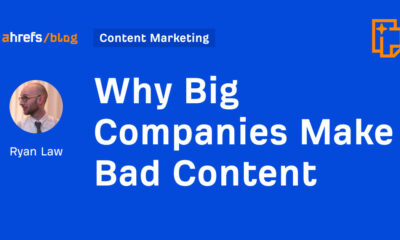SOCIAL
Meta Outlines Key Areas of Focus, and Business Opportunity, Following Downbeat Earnings Report

After a disastrous earnings report, in which Meta informed the market that its net income was at its lowest levels since 2019 in the most recent quarter, largely due to ongoing, and rising investment in its metaverse vision, Meta has sought to reassure investors that it has a plan to get its financial performance back on track, despite rising challenges in the digital ads space.
In the accompanying earnings call, Meta CEO Mark Zuckerberg outlined the company’s four key areas of focus moving forward.
Those are:
- Improving its AI discovery tools to maximize engagement in its apps
- Adding new business messaging features to monetize the user shift towards messaging, and away from social apps
- Re-building its ad tools to reduce reliance on user data
- Continued development of AR, VR and the metaverse, with a focus on the future
Here’s a look at how Meta is planning to tackle each:
Improving its AI discovery tools
The first point has already proven contentious, with users pushing back against Meta increasingly looking to pump more content from profiles that you don’t follow into news feeds.
This approach, which was guided by TikTok, aims to maximize the value of the content available in each app, by highlighting the best, most engaging posts, regardless of who posted them, to more users. In the past, both apps have pushed users to curate their own streams, based on their interests, but now, Meta’s confident that its AI tools will be able to show you more of what you like in its apps, even if you don’t know that it exists.
And in variance to TikTok, Meta says that it can actually provide a better experience on this front, because it can also apply its AI content matching across a wider range of content types, including photos, text, links, communities, and all kinds of videos.
“We can also mix this content alongside posts from your family and friends, which can’t be generated by AI alone.”
The assumption here is that users actually want all of these different types of content on a single platform, as opposed to TikTok, where you just get a constant stream of video clips. Whether that’s true or not is unclear, but TikTok continues to engage more users for longer, so it doesn’t seem to be a problem impeding its growth.
Which, in turn, may mean that it’s not a competitive advantage for Meta either.
Either way, the amount of AI-recommended content is only going to increase in Meta’s apps.
Back in July, Zuckerberg noted that:
“Right now, about 15% of content in a person’s Facebook feed and a little more than that of their Instagram feed is recommended by our AI from people, groups, or accounts that you don’t follow. We expect these numbers to more than double by the end of next year.”
Shortly after Zuckerberg said this, Instagram announced that it was scaling back its AI recommendations due to negative feedback, but over time, you can indeed expect Meta to show you more and more stuff, from all different types of users and profiles – whether you’ve chosen to see it or not.
Which is a big shift, especially given Meta’s past insistence that it needs an algorithm to sort through all the posts it could show you, because people simply follow too many people and Pages to show you everything from all of them, every day.
Now, it seems, the opposite is true. Which leads into the second element.
Monetizing the user shift towards messaging
More people are now sharing more content with smaller groups of people in their DMs, as opposed to posting public updates to Facebook or Instagram.
This shift is actually present across all social apps, with a new report published this week also showing that usage among Twitter’s most active users has been in steady decline since the beginning of the pandemic.
The reasons for this are varied. One contention is that, due to the ongoing polarizing impacts of political commentary on social networks, mare users are now increasingly inclined to keep their opinions to themselves, or to share them with a smaller group of trusted friends, rather than broadcasting them for everyone to see, criticize and attack them over.
Meta highlighted this as a key concern among its users last year, with Zuckerberg noting:
“One of the top pieces of feedback we’re hearing from our community right now is that people don’t want politics and fighting to take over their experience on our services.”
There have also been various high-profile cases of celebrities being brought down when their past, offensive tweets have been uncovered, while the shift towards more entertaining content – again driven by TikTok – has also made regular updates feel more stale and less engaging.
The result, then, is that people just aren’t posting as many feed updates as they once did. And with that, Meta’s looking to tap into the resulting growth in messaging as a potential revenue opportunity.
Even though it’s never been able to effectively monetize messaging in the past.
But it, possibly, has a plan:
“As more social interactions move to messaging, we’re developing a flywheel between discovery and messaging that will make all these apps stronger. On Instagram alone, people already reshare Reels nearly 1 billion times daily through DMs.”
Meta’s also working to monetize WhatsApp, with Zuckerberg specifically noting that ‘paid messaging is going to be ‘a big opportunity’ moving forward.
On this front, Meta points to opportunities like:
- Click-to-Messaging ads, which let businesses run ads on Facebook and Instagram that start a thread on Messenger, WhatsApp or Instagram Direct so they can communicate with customers directly. This is one of our fastest growing ads products, with a $9 billion annual run rate.
- Click-to-WhatsApp also just passed a $1.5 billion run rate, growing more than 80% year-over-year.
Whether Meta is able to effectively monetize messaging is a big question, but you can expect it to keep highlighting the potential tapping into the growth of messaging as a means to maximize your marketing and brand-building efforts.
I remain unconvinced that users are super keen to message with businesses, but there may be new ways for Meta to tap into this shift.
Re-building its ad tools to reduce reliance on user data
Meta’s also losing out on ad dollars due to Apple’s iOS 14 privacy updates, which got even worse this week when Apple announced a new App Store tariff on post ‘boosting’ on social platforms.
In response to this, Meta’s looking to improve its AI and machine learning solutions to better automate ad targeting, based on the insights that it can use, as opposed to leaving it up to advertisers to select specific audience subsets which may not be as effective.
This is a tough sell, because for years, Meta has touted its unmatched audience insights as a means to hone in your ad targeting, and reach just the right audiences with your promotions. Now, it’s saying that you should trust its AI black box to display your ads to the right people, even if you have no idea who they are.
Meta’s main solution on this front is its Advantage+ ad suite, which cuts out all of the targeting, and just asks advertisers to set a budget, a date range, and to upload their creative – Meta’s system will do the rest.
Which many will feel uncertain about – but Meta says that its systems are producing results:
“Recent testing found that advertisers using Advantage+ shopping campaigns saw a 17% improvement in their Cost Per Acquisition and 32% increase in Return on Ad Spend.”
Meta’s continuing to evolve its tools, and it may well be that its systems do end up producing better response rates than your own targeting would. It puts a lot of trust in Meta’s systems, but if it works…
Eventually, you may not need to do much manual work on your Facebook and IG ads at all, just upload your creative, set a budget, and let the system do the rest.
And then, finally, there’s the metaverse, and the theoretical opportunities of the theoretical VR wondersphere, where anything and everything will be possible.
Eventually.
I have no doubt that the metaverse will become a thing, and that these more immersive experiences will grow into more habitual, transformational trends at some stage. I’m just not sure when that will be. Meta says that it’s a decade out, and it may be even more than that, while various other non-Meta execs say it’s a path to failure, littered with health impacts, dangers, regulatory concerns, etc.
Either way you look at it, the metaverse is not close, with widespread adoption of VR headsets, or potentially AR glasses, being the first big step that needs to happen before you even need to consider what the opportunities might be here.
But Meta remains confident that it will be a thing, and over time, we’ll see what sort of applications and tools emerge in VR that draw people into the experience.
When you see those trends shift, you’ll need to pay attention – but till that happens, it’s largely academic. And if any advisers are telling you that you need a metaverse strategy, I’d probably be assessing how much money they stand to make from such, in variance to the potential value for your business.
SOCIAL
Snapchat Explores New Messaging Retention Feature: A Game-Changer or Risky Move?

In a recent announcement, Snapchat revealed a groundbreaking update that challenges its traditional design ethos. The platform is experimenting with an option that allows users to defy the 24-hour auto-delete rule, a feature synonymous with Snapchat’s ephemeral messaging model.
The proposed change aims to introduce a “Never delete” option in messaging retention settings, aligning Snapchat more closely with conventional messaging apps. While this move may blur Snapchat’s distinctive selling point, Snap appears convinced of its necessity.
According to Snap, the decision stems from user feedback and a commitment to innovation based on user needs. The company aims to provide greater flexibility and control over conversations, catering to the preferences of its community.
Currently undergoing trials in select markets, the new feature empowers users to adjust retention settings on a conversation-by-conversation basis. Flexibility remains paramount, with participants able to modify settings within chats and receive in-chat notifications to ensure transparency.
Snapchat underscores that the default auto-delete feature will persist, reinforcing its design philosophy centered on ephemerality. However, with the app gaining traction as a primary messaging platform, the option offers users a means to preserve longer chat histories.
The update marks a pivotal moment for Snapchat, renowned for its disappearing message premise, especially popular among younger demographics. Retaining this focus has been pivotal to Snapchat’s identity, but the shift suggests a broader strategy aimed at diversifying its user base.
This strategy may appeal particularly to older demographics, potentially extending Snapchat’s relevance as users age. By emulating features of conventional messaging platforms, Snapchat seeks to enhance its appeal and broaden its reach.
Yet, the introduction of message retention poses questions about Snapchat’s uniqueness. While addressing user demands, the risk of diluting Snapchat’s distinctiveness looms large.
As Snapchat ventures into uncharted territory, the outcome of this experiment remains uncertain. Will message retention propel Snapchat to new heights, or will it compromise the platform’s uniqueness?
Only time will tell.
SOCIAL
Catering to specific audience boosts your business, says accountant turned coach

While it is tempting to try to appeal to a broad audience, the founder of alcohol-free coaching service Just the Tonic, Sandra Parker, believes the best thing you can do for your business is focus on your niche. Here’s how she did just that.
When running a business, reaching out to as many clients as possible can be tempting. But it also risks making your marketing “too generic,” warns Sandra Parker, the founder of Just The Tonic Coaching.
“From the very start of my business, I knew exactly who I could help and who I couldn’t,” Parker told My Biggest Lessons.
Parker struggled with alcohol dependence as a young professional. Today, her business targets high-achieving individuals who face challenges similar to those she had early in her career.
“I understand their frustrations, I understand their fears, and I understand their coping mechanisms and the stories they’re telling themselves,” Parker said. “Because of that, I’m able to market very effectively, to speak in a language that they understand, and am able to reach them.”Â
“I believe that it’s really important that you know exactly who your customer or your client is, and you target them, and you resist the temptation to make your marketing too generic to try and reach everyone,” she explained.
“If you speak specifically to your target clients, you will reach them, and I believe that’s the way that you’re going to be more successful.
Watch the video for more of Sandra Parker’s biggest lessons.
SOCIAL
Instagram Tests Live-Stream Games to Enhance Engagement

Instagram’s testing out some new options to help spice up your live-streams in the app, with some live broadcasters now able to select a game that they can play with viewers in-stream.
As you can see in these example screens, posted by Ahmed Ghanem, some creators now have the option to play either “This or That”, a question and answer prompt that you can share with your viewers, or “Trivia”, to generate more engagement within your IG live-streams.
That could be a simple way to spark more conversation and interaction, which could then lead into further engagement opportunities from your live audience.
Meta’s been exploring more ways to make live-streaming a bigger consideration for IG creators, with a view to live-streams potentially catching on with more users.
That includes the gradual expansion of its “Stars” live-stream donation program, giving more creators in more regions a means to accept donations from live-stream viewers, while back in December, Instagram also added some new options to make it easier to go live using third-party tools via desktop PCs.
Live streaming has been a major shift in China, where shopping live-streams, in particular, have led to massive opportunities for streaming platforms. They haven’t caught on in the same way in Western regions, but as TikTok and YouTube look to push live-stream adoption, there is still a chance that they will become a much bigger element in future.
Which is why IG is also trying to stay in touch, and add more ways for its creators to engage via streams. Live-stream games is another element within this, which could make this a better community-building, and potentially sales-driving option.
We’ve asked Instagram for more information on this test, and we’ll update this post if/when we hear back.
-

 SEO7 days ago
SEO7 days agoWhy Big Companies Make Bad Content
-

 SEO7 days ago
SEO7 days agoHow To Drive Pipeline With A Silo-Free Strategy
-

 PPC7 days ago
PPC7 days ago26 Ready-to-Go AI Prompts for Social Media
-

 MARKETING6 days ago
MARKETING6 days agoGenerative Engine Optimization Framework Introduced in New Research
-
SEARCHENGINES4 days ago
Daily Search Forum Recap: May 3, 2024
-

 MARKETING5 days ago
MARKETING5 days agoLet’s Start Treating Content More Like We Treat Code
-

 MARKETING4 days ago
MARKETING4 days agoTinuiti Recognized in Forrester Report for Media Management Excellence
-

 MARKETING4 days ago
MARKETING4 days agoHow Tagging Strategies Transform Marketing Campaigns













You must be logged in to post a comment Login